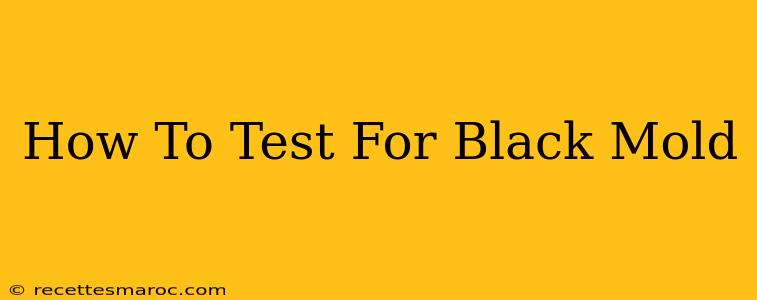Black mold, or Stachybotrys chartarum, is a type of mold that can cause serious health problems if left untreated. Knowing how to test for black mold is crucial for protecting your home and your family's well-being. This guide provides a step-by-step process, from identifying potential areas to understanding test results.
Identifying Potential Black Mold Growth Areas
Before you start testing, it's important to know where to look. Black mold thrives in damp, dark, and humid environments. Common areas include:
- Bathrooms: Look behind shower tiles, under sinks, and around caulking.
- Kitchens: Check around leaky pipes, under sinks, and near dishwashers.
- Basements: Basements are particularly susceptible due to high humidity and potential water leaks. Examine walls, floors, and crawl spaces.
- Attics: Poor ventilation can lead to moisture buildup in attics.
- Areas with water damage: After floods, leaks, or plumbing issues, carefully inspect affected areas for mold growth.
Visual Inspection: The First Step
While a visual inspection isn't a definitive test, it's a crucial first step. Black mold often appears dark greenish-black or sometimes even sooty black. However, be aware that not all black mold is Stachybotrys chartarum; many other types of mold can appear dark in color. Do not touch or disturb suspected mold without proper protection.
Testing for Black Mold: Methods and Considerations
There are several methods for testing for black mold. Each has its advantages and disadvantages:
1. DIY Mold Test Kits: Convenient but Limited
Home mold test kits are readily available at most hardware stores. These kits typically involve collecting a sample of the suspected mold and sending it to a lab for analysis. While convenient, DIY kits often lack the precision of professional testing and may not identify the specific type of mold present. The results can also be subjective and sometimes unreliable.
2. Professional Mold Testing: Accurate and Comprehensive
Professional mold inspectors use advanced techniques and equipment to accurately identify and quantify mold growth. They can perform:
- Air sampling: Measures the amount of mold spores in the air. This is useful for determining the overall mold contamination level in a home.
- Surface sampling: Collects samples from surfaces to identify the type and extent of mold growth. This method is more targeted than air sampling.
- Bulk sampling: This involves removing a larger sample of material (e.g., drywall) which is often used for more severe mold problems.
Professional testing provides a much more accurate and comprehensive assessment of the mold problem than a DIY kit. The results are generally more reliable and can help guide remediation efforts.
3. Understanding Test Results
Regardless of the testing method you choose, understanding the results is critical. A positive test for Stachybotrys chartarum requires professional remediation. Never attempt to remove black mold yourself without proper training and safety equipment. Mold removal requires specialized equipment and procedures to prevent further spread and potential health risks.
Preventing Black Mold Growth: Proactive Measures
Preventing mold growth is always better than dealing with it after it's established. Here are some key preventative measures:
- Maintain proper ventilation: Ensure adequate ventilation in bathrooms, kitchens, and basements to reduce humidity.
- Address leaks promptly: Repair any leaks promptly to prevent moisture buildup.
- Use dehumidifiers: In damp areas, use dehumidifiers to control humidity levels.
- Regularly clean: Regularly clean and disinfect surfaces to prevent mold spores from germinating.
Black mold is a serious issue that requires prompt attention. By understanding how to test for black mold and taking preventative measures, you can protect your health and your home. Remember to consult with a qualified professional for accurate diagnosis and remediation.

